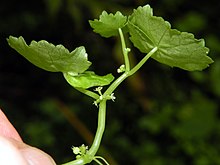
Tubers are a type of enlarged structure that plants use as storage organs for nutrients, derived from stems or roots. Tubers help plants perennate, provide energy and nutrients, and are a means of asexual reproduction.

Weed control is a type of pest control, which attempts to stop or reduce growth of weeds, especially noxious weeds, with the aim of reducing their competition with desired flora and fauna including domesticated plants and livestock, and in natural settings preventing non native species competing with native species.

The Jerusalem artichoke, also called sunroot, sunchoke, wild sunflower, topinambur, or earth apple, is a species of sunflower native to central North America. It is cultivated widely across the temperate zone for its tuber, which is used as a root vegetable.

Ilex opaca, the American holly, is a species of holly, native to the eastern and south-central United States, from coastal Massachusetts south to central Florida, and west to southeastern Missouri and eastern Texas.
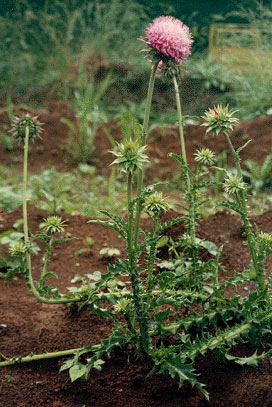
Carduus nutans is a biennial plant in the daisy and sunflower family Asteraceae with the common names musk thistle, nodding thistle, and nodding plumeless thistle. It is native to regions of Europe, Central Asia, and North Africa, where it is a scattered pasture plant. The musk thistle has been declared as invasive in North America, Australia, New Zealand, and South Africa.

In biology, stolons, also known as runners, are horizontal connections between parts of an organism. They may be part of the organism, or of its skeleton. Typically, animal stolons are exoskeletons.
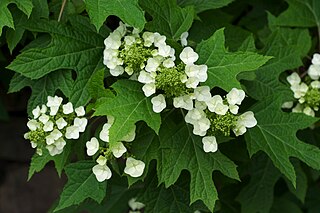
Hydrangea quercifolia, commonly known as oakleaf hydrangea or oak-leaved hydrangea, is a species of flowering plant in the family Hydrangeaceae. It is native to the southeastern United States, in woodland habitats from North Carolina west to Tennessee, and south to Florida and Louisiana. A deciduous shrub with white showy flower heads, it is grown as a garden plant, with numerous cultivars available commercially.

Apios americana, sometimes called the American groundnut, potato bean, hopniss, Indian potato, hodoimo, America-hodoimo, cinnamon vine, or groundnut is a perennial vine that bears edible beans and large edible tubers.

Sagittaria latifolia is a plant found in shallow wetlands and is sometimes known as broadleaf arrowhead, duck-potato, Indian potato, or wapato. This plant produces edible tubers that have traditionally been extensively used by Native Americans.

Hydrocotyle umbellata is an aquatic plant that thrives in wet, sandy habitat. Its English common name is manyflower marshpennywort or dollarweed. It is native to North America and parts of South America. In Brazil it is known as acariçoba and has applications in herbal medicine with purported anxiolytic, analgesic and anti-inflammatory properties. It can also be found growing as an introduced species and sometimes a noxious weed on other continents. It is an edible weed that can be used in salads or as a pot herb.
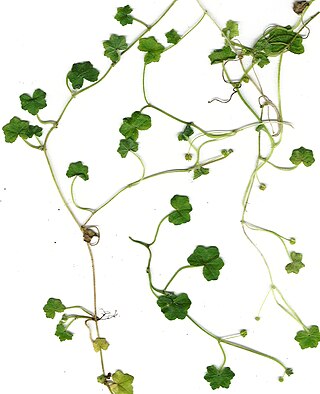
Hydrocotyle, also called floating pennywort, water pennywort, Indian pennywort, dollar weed, marsh penny, thick-leaved pennywort and white rot, is a genus of prostrate, perennial aquatic or semi-aquatic plants formerly classified in the family Apiaceae, now in the family Araliaceae.

Anredera cordifolia, commonly known as the Madeira vine or mignonette vine, is a South American species of ornamental succulent vine of the family Basellaceae. The combination of fleshy leaves and thick aerial tubers makes this a very heavy vine. It smothers trees and other vegetation it grows on and can easily break branches and bring down entire trees on its own. Other names include lamb's tail and potato vine.

Hydrocotyle ranunculoides, known commonly as floating pennywort, or floating marshpennywort, is an aquatic plant in the family Apiaceae. It is native to North and South America.
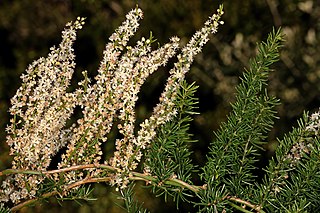
Asparagus aethiopicus, Sprenger's asparagus, is a plant native to the Cape Provinces and the Northern Provinces of South Africa. Often used as an ornamental plant, it is considered an invasive weed in many locations. Asparagus fern, asparagus grass and foxtail fern are common names; however, it is unrelated to true ferns. A. aethiopicus has been confused with A. densiflorus, now regarded as a separate species, so that information about A. aethiopicus will often be found under the name A. densiflorus.
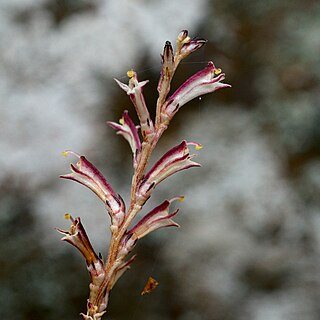
Epifagus virginiana, commonly called beech drops, is an obligate parasitic plant which grows and subsists on the roots of American beech. It is a member of the family Orobanchaceae. The genus Epifagus is monotypic—containing only E. virginiana. The name Epifagus derives from Greek "epi" meaning "on" or "upon", and "Fagus" which is the genus name of beech.

Sagittaria platyphylla, the delta arrowhead, broad-leaf arrowhead or delta duck-potato, is a plant species native to the eastern United States.

Houstonia serpyllifolia, commonly called thymeleaf bluet, creeping bluet, mountain bluet, Appalachian bluet or Michaux's bluets is a species of plant in the coffee family (Rubiaceae). It is native to the eastern United States, where it is found in the central and southern Appalachian Mountains. It has been documented in the states of Pennsylvania, Maryland, West Virginia, western Virginia, North Carolina, South Carolina, Kentucky, Tennessee, Ohio, and northeastern Georgia.
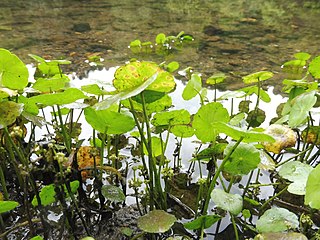
Hydrocotyle prolifera, commonly called whorled marshpennywort , is a species of flowering plant in the ginseng family (Araliaceae). It is native to North America and South America, where it is widespread. In the United States, it is largely restricted to the southeastern and southwestern regions. Its natural habitat is in swamp forests, or in pools of standing water.
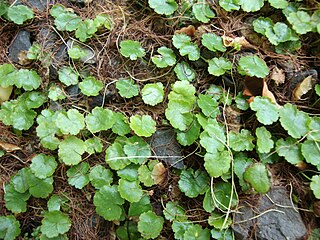
Hydrocotyle sibthorpioides is a small species of flowering plant native to southeastern Asia. It is also referred to as lawn marshpennywort. It is a dicot, traditionally placed in the family Apiaceae, but more recently suggested to belong in the Araliaceae. It grows in abundance when the conditions are right. Hydrocotyle sibthorpioides originated in southeastern Asia, but is slowly spreading in the United States, along with other places around the world. It can grow in a wide variety of habitats. It has been used for medicinal purposes in Asia and is also common in the aquarium trade.

Tiarella stolonifera is a species of flowering plant in the family Saxifragaceae. The specific name stolonifera means "spreading by stolons", an important characteristic of this species. Known as the creeping foamflower, it has the widest range of any species of Tiarella in eastern North America.
